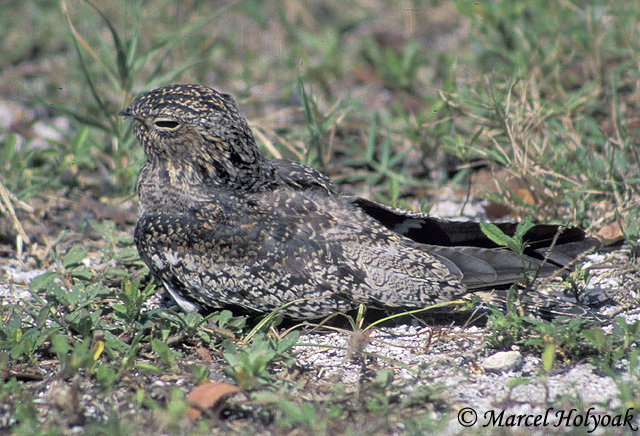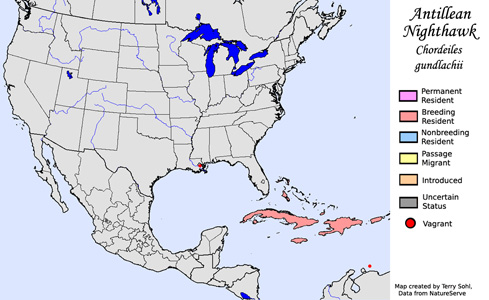| Length: 8.5 inches | Wingspan: 21 inches | Seasonality: Non-resident in South Dakota |
| ID Keys: Mottled gray, with buffy patches on wing coverts and belly, barring below | ||
 The
Antillean Nighthawk and the Common
Nighthawk were once considered one species before being split. The
Antillean Nighthawk has a buffier tone on its underparts, as well as other
minor plumage differences, and has a distinctly different voice. While
Common Nighthawks are widely spread across North America, the Antillean
Nighthawk is just a summer visitors to the Florida Keys and parts of
southern Florida, with only very rare sightings outside of that range in
North America. They are actually relative new comers to North America, with
the first sighting in Florida occurring in 1941. It is thought that clearing
of land in the Florida Keys and in parts of Southern Florida provided more
open ground for nesting for the species, and provided an opportunity for
range expansion.
The
Antillean Nighthawk and the Common
Nighthawk were once considered one species before being split. The
Antillean Nighthawk has a buffier tone on its underparts, as well as other
minor plumage differences, and has a distinctly different voice. While
Common Nighthawks are widely spread across North America, the Antillean
Nighthawk is just a summer visitors to the Florida Keys and parts of
southern Florida, with only very rare sightings outside of that range in
North America. They are actually relative new comers to North America, with
the first sighting in Florida occurring in 1941. It is thought that clearing
of land in the Florida Keys and in parts of Southern Florida provided more
open ground for nesting for the species, and provided an opportunity for
range expansion.
Habitat: Found in open habitats with patches of bare ground for nesting. In their Florida range, they are often found in disturbed areas or wide-open "developed" land such as airports and vacant lots. In the Caribbean, they are found in open fields, disturbed areas, and open woodlands.
Diet: Feeds on insects.
Behavior: Feeds by swooping through the air in pursuit of flying insects, using a mouth that opens extraordinarily wide.
Nesting: No nest is built, the female lays a single egg directly on the ground in an area with little growing vegetation. The female does the majority of the incubation of eggs, but upon the eggs hatching, both parents help to feed the young regurgitated insects. The young typically fledge after about 3 weeks.
Interactive eBird Map: Click to access an interactive eBird map of Antillean Nighthawk sightings
Song: The male Antillean Nighthawk has a call consisting of multiple quick, staccato notes that descend in pitch. Sometimes referred to as a "pitty-pit-pit" call.
Migration: Those in the United States are only present during the summer months. Migration patterns are poorly known, but most Antillean Nighthawks likely winter in northern South America.
Similar Species: Common Nighthawk, Lesser Nighthawk
Conservation Status: Populations are large and appear to be stable. The IUCN lists the Antillean Nighthawk as a species of "Least Concern".
Further Information: 1) BirdLife International - Antillean Nighthawk
2) Audubon Guide - Antillean Nighthawk
3) Florida Fish and Wildlife Conservation Commission - Antillean Nighthawk
Photo Information: Photo taken by Marcel Holyoak - April 23rd, 1998 - Dry Tortugas, Florida - Photo licensed under Creative Commons Attribution NonCommercial NoDerivs 2.0 Generic License
| Click below for a higher-resolution map |
 |
| South Dakota Status: Non-resident in South Dakota |
Additional Antillean Nighthawk Photos (coming soon!!)
